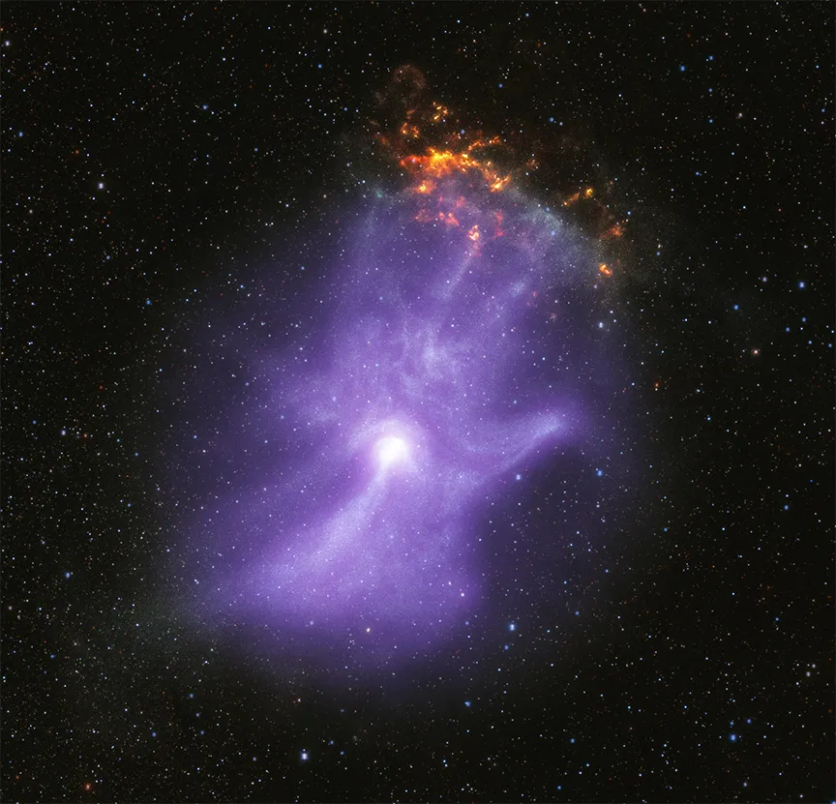In a Halloween-worthy cosmic revelation, NASA's "spooktacular" Imaging X-ray Polarimetry Explorer (IXPE) has ventured into the eerie expanse of MSH 15-52, a celestial structure reminiscent of a skeletal hand.
This marks the lengthiest gaze at a single object by IXPE since its launch in December 2021.
Magnetic Field Bones
Roger Romani of Stanford University, leading the study, said, "The IXPE data gives us the first map of the magnetic field in the 'hand'.
The charged particles producing the X-rays travel along the magnetic field, determining the basic shape of the nebula like the bones do in a person's hand."

Drawing a parallel to Wilhelm Röntgen's use of X-rays to unveil the bones in a human hand in 1895, two of NASA's X-ray space telescopes have now unraveled the magnetic field "bones" of a mesmerizing hand-shaped structure in space.
Together, these telescopes illuminate the behavior of a once vibrant star that now persists through surges of charged particles, bridging the realms of matter and antimatter.
Around 1,500 years ago, a colossal star in our Galaxy exhausted its nuclear fuel. This cataclysmic event led to the formation of a dense entity known as a neutron star.
According to NASA, pulsars, rapidly rotating neutron stars endowed with potent magnetic fields, serve as laboratories for extreme physics, offering conditions beyond earthly replication.
Young pulsars can generate streams of matter and antimatter emanating from their poles, coupled with a potent wind, forming what is known as a "pulsar wind nebula."
The Nebula's 'Palm'
In 2001, NASA's Chandra X-ray Observatory chanced upon the pulsar PSR B1509-58 and revealed that its pulsar wind nebula, named MSH 15-52, strikingly resembles a human hand. The pulsar is nestled at the base of the nebula's "palm," situated a staggering 16,000 light-years from our home planet.
IXPE unravels the electric field orientation of X-rays, influenced by the magnetic field of the X-ray source, a phenomenon known as X-ray polarization. Across vast stretches of MSH 15-52, the polarization levels soar to impressive heights, aligning with theoretical projections.
Josephine Wong, a co-author from Stanford, highlighted, "We're all familiar with X-rays as a diagnostic medical tool for humans. Here we're using X-rays in a different way, but they are again revealing information that is otherwise hidden from us."
A fascinating feature of MSH 15-52 is a luminous X-ray jet extending from the pulsar to the nebula's "wrist" at the lower end of the image.
The fresh IXPE data illuminate that the polarization at the onset of the jet is subdued, likely due to the turbulent magnetic fields linked with high-energy particle generation.
As the jet progresses, the magnetic field lines appear to straighten and become notably uniform, leading to a surge in polarization.
These revelations suggest that particles receive an energy boost in the turbulent domains near the pulsar's palm, eventually streaming toward areas where the magnetic field follows a uniform path along the wrist, fingers, and thumb, as explained by NASA.
Related Article : NASA's Picture of the Day Features Spooky, Halloween-Like Scene in the Ghost Nebula

ⓒ 2025 TECHTIMES.com All rights reserved. Do not reproduce without permission.


![Best Gaming Mouse For Gamers With Smaller Hands [2025]](https://d.techtimes.com/en/full/461466/best-gaming-mouse-gamers-smaller-hands-2025.png?w=184&h=103&f=6fd057ef777bd39251d4e7e82e9b23f1)

